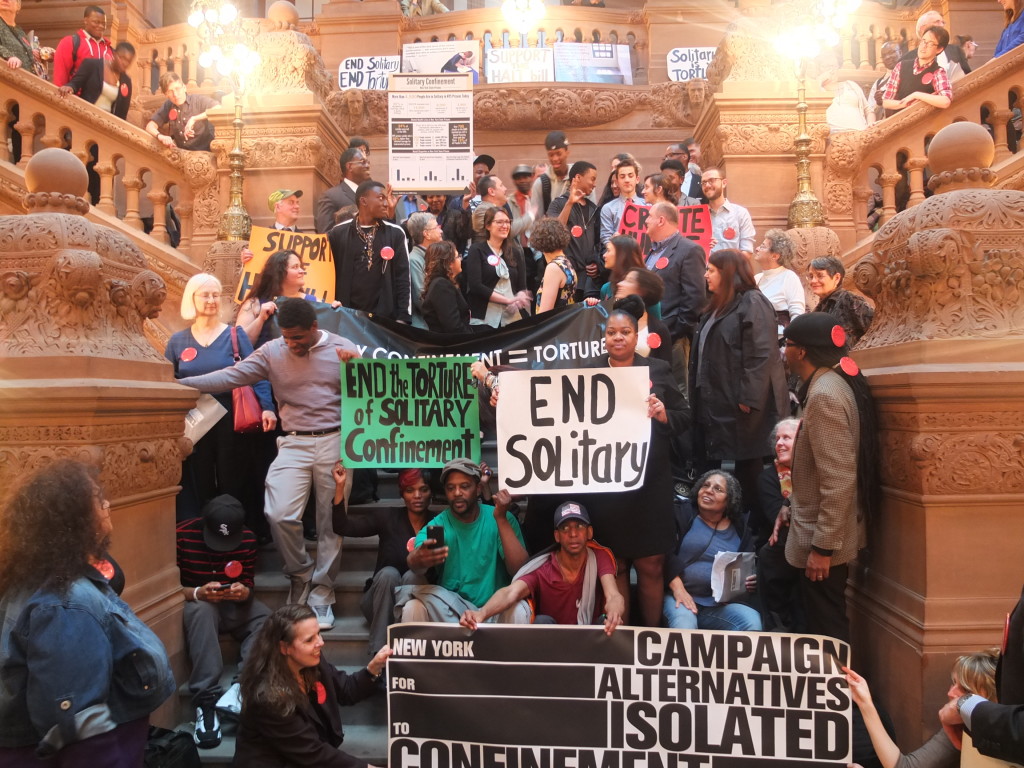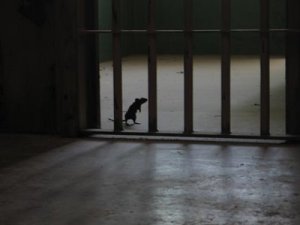By Marco Poggio. Reprinted from Solitary Watch.
A bill to significantly limit the use solitary confinement in New York state prison and local jails gained momentum last week, after nine Assembly members and two state senators agreed to support the legislation. The new sponsorships, secured after a day of lobbying that brought more than 120 activists to Albany from around the state, brought the total number of co-sponsors to 33 in the Assembly and 11 in the Senate.
Citing the words of the United Nations Special Rapporteur on Torture Juan Méndez, who condemned long-term solitary confinement as torture, advocates convinced the legislators of the urgency of a sweeping bill called the Humane Alternatives to Long-Term (HALT) Solitary Confinement Act, which would limit the maximum time of isolation to 15 consecutive days, and a maximum of 20 days over any 60-day period.
The bill would also completely ban the use of isolation on individuals with mental illness, as well as youth, seniors, pregnant women and nursing mothers, and members of the LGBTQI community—groups that are particularly vulnerable to the effects of solitary, or prone to abuse while in solitary, or both
“The practice of solitary confinement is subject to widespread abuse,” Méndez said in a videotaped statement, which was played at an educational event held on the morning of April 22 in the Legislative Office Building. “It leads to the violations of fundamental human rights, including the right to personal, physical or mental integrity, and may constitutes cruel and inhumane treatment, and even torture.”
Scientific evidence shows that people who are held in isolation for 22 to 24 hours a day suffer severe irreversible psychological damage, Méndez said, adding that long-term solitary confinement “must be absolutely prohibited.”
Studies have shown that people held in isolation often develop acute forms of paranoia and psychosis that cause them to mutilate themselves, and in many cases, to commit suicide.
Figures obtained by the Correctional Association of New York from the New York State Department of Corrections and Community Supervision (DOCCS) indicate that the rate of suicide in New York state prison is 59 percent higher than the national average for incarcerated persons.
Among the individuals who took his own life while being held in isolation was Benjamin Van Zandt, whose mother, Alicia Barraza, also spoke at the morning event.
Van Zandt was arrested and charged for arson when he was 17. Despite being diagnosed with mental health problems, he was placed in solitary confinement multiple times over the course of three years. He reportedly also endured repeated physical and sexual abuse at the hand of other incarcerated with him at Fishkill Correctional Center. At some point during his downward path through despair and acute depression, Van Zandt decided his life wasn’t worth living, and hanged himself in his cell at the age of 21.
Since her son’s death, Barazza has become a passionate advocate for the HALT Solitary Confinement Act. “There is absolutely no reason that another family should have to endure what we went through,” Barazza said
“I think we should put an end to the number of suicides that come from solitary confinement” said Selestina Martinez, a social worker born and raised in the Bronx who joined in the lobbying, which was organized by an advocacy group called the New York Campaign for Alternatives to Isolated Confinement (CAIC).
Martinez’s cousin, who has completed 23 years of a 25-year sentence, spent large portions of his time in solitary confinement. Now that he only has two years left before he will be released, Martinez said, her cousin is frightened to come home because he doesn’t know how he will be able re-enter society after a long time spent in isolation.
“It’s kinda like throwing somebody into the water and expecting them to swim when they don’t know how,” she said, referring to people who have done time in solitary confinement.
“I’ve Known Men Who Lost Their Minds”
Across the country, at least 80,000 people are being held in some form of isolated confinement, locked down in one- or two-person cells for 23 to 24 hours a day. In New York State prisons, the number is about 4,500 at any given time. Each year in the state of New York, the Corrections Department sentences over 14,000 people to terms in so-called Special Housing Units (SHUs).
About 8,000 of those sentences, roughly 57 percent, result in three or more months in the ‘box,’ as solitary confinement is commonly called by those who experience it. About 3,900 of the sentences, nearly 28 percent of the total, send people to isolation for six months or longer. Some individuals are kept in “disciplinary segregation” for years at the time, while “administrative segregation” can last for decades.
“I’ve known men who lost their minds,” said Tyrrell Muhammad, who spent seven consecutive years in solitary confinement, and spoke of his experiences at the morning event. During each day in isolation, Muhammad said, he had to fight hard to stay sane.
A few week after entering solitary confinement, Muhammad began suffering the consequences of extreme isolation and idleness.
First, he began having hallucinations while staring for hours at the flaking paint on the walls, which he saw transforming into the faces of famous people. One time, Muhammad said, he recognized Dr. Jay, a basketball star who played during the 1970s. Another time, he saw the face of Abraham Lincoln.
“This is how you could tell you’re slipping,” Muhammad told Solitary Watch. After more time spent in complete isolation, Muhammad said, he often would not realize he had been talking to himself loudly for hours until a guard outside his cell told him to be quiet.
Contrary to what is commonly thought, only in a small number of cases people are put in isolation because of violent behaviour inside prisons or jails. Most of the time, they end up in solitary confinement for minor actions that are considered to be in violations of prison regulations, for example having too many postal stamps, occupying the wrong side of the cell, or talking back to a correctional officer.
Pushing Legislation to Limit Solitary Confinement
The April 22nd morning press event featured sponsors of three bills to limit solitary confinement. A bill introduced by Assembly Correction Committee chair Daniel J. O’Donnell would ban solitary for youth and people with developmental disabilities, as well as individuals with mental illness, and states that solitary confinement sanctions be imposed as a measure of last resort, and for the minimum period necessary. . A bill already passed by the Assembly, after being introduced by Nily Rozic, bans solitary for pregnant women.
The lead sponsors of the HALT Solitary Confinement Act also spoke at the event. Assembly Member Jeffrion Aubry and State Senator William Perkins originally introduced the bill in January 2014.
“We have a human rights crisis here in New York State. The cost of solitary confinement as a state and a society are immeasurable,” said Perkins, a democrat from Harlem. “The encouraging news is that legislators, advocates, and the public have finally come together.”
The HALT Solitary Confinement Act does more than simply reducing the use of solitary confinement. It also seeks to create alternative Residential Rehabilitation Units (RRU), which would substitute the isolation and deprivation of the SHU with treatment and programs of rehabilitation that would help incarcerated people prepare for their transition back into the general population and the outside world.
On April 22, advocates for the bill met with legislators and staffs throughout the day. Organized in teams of four or five, activists spelled out the key features of the bill to Assembly members and state senators, some of whom were not yet familiar with the issue of solitary confinement. In some of the meetings, activists directly affected by incarceration system were able to share their life stories with the legislators.
Tama Bell, the mother of a 23-year old man who’s currently in jail, told Assembly Member David Weprin her son ended up in solitary confinement despite a long history of mental illness and after being diagnosed with a serious form of bipolar disorder.
After only month locked up in a cell alone the size of an elevator, Bell said, her son began talking about suicide. She reached out to the elected officials in her district, and contacted both the state’s Department of Correction and the Office of Mental Health to let the officials know about her son’s situation. Finally, her son’s solitary confinement sentenced was reduced from 18 months to three.
“I can’t even imagine him making it through beyond the three months,” Bell said, adding how lucky she feels that his son is still alive. Were the HALT Solitary Confinement Act in place, her son would have never walked inside an isolation cell in the first place.
While her intervention helped improving the condition of her son, there are large numbers of less fortunate children whose families have no means to get them out of isolation.
Weprin was among the first Assembly members last week to add his name to the list of those who sponsor the legislation. By the end of day last Wednesday, six more Assembly members had decided to co-sponsor the bill, a sign that advocates have been effective in getting the attention of the elected officials on the issue of solitary confinement.
“So many people did so much to make this day a success,” Scott Paltrowitz, Associate Director of the Prison Visiting Project at the Correctional Association of New York and an organizer of day’s events.
“I feel honored, inspired, blessed, humbled and excited to be part of a movement that is challenging such horrific practices with such fierce advocacy, passion, dedication, energy, and love,” Paltrowitz wrote in an email to the activists who took part in the lobby day.
The dozens of activists coming from all across the state, organized by the Campaign for Alternatives to Isolated Confinement (CAIC), included a heterogeneous mix of people from different walks of life. While individuals cited different motives for taking part in the day, all of them share the belief that solitary confinement is inhumane and degrading.
“I’m here just because I don’t want to live in a country where we treat anybody like this,” said Shirley Ripullone, who lives in Columbia County.
“As an American who believes in the stated values of our country, I hate to see us acting [in a way] that if it were happening anywhere else we would be wary and self-righteous about it,” said Kenneth Stahl, a man who had no direct experience with solitary confinement but decided to mobilize in favor of the bill out of his own moral principles.
Social workers, lawyers, members of religious communities, and people from the general public were joined by formerly incarcerated people and families of currently incarcerated people in an action that defied demographics.
A Long Road Ahead
Although lobbying efforts in Albany were successful, there are still significant obstacles that sweeping legislation like the HALT Solitary Confinement Bill will have to overcome before it will be able to make it to the floor of the Assembly, much less the Republican-controlled Senate.
Partisan divisions are only part of the problem. Geographic and demographic splits also play a role in opinions on solitary confinement. As illustrated in an infographic distributed by CAIC, African Americans are even more over-represented in solitary confinement than they are in the prison population. In addition, while a majority of incarcerated people come from New York City, most prisons are located upstate, and most prison staff are white.
Political support for solitary confinement is still large around the state, especially in those counties where the local economy relies heavily of the business of correction facilities, and where correctional officer unions have powerful connections inside the state legislature.
Even in a liberal stronghold like New York City, where Mayor Bill de Blasio pledged to fix a correction system plagued by violence and dysfunction, reforms have taken place amid a climate of caution and sometimes skepticism.
“I don’t think it is cruel and unusual,” said Correction Department Commissioner Joseph Ponte in regard of solitary confinement, during a hearing at City Council last month.
But people who have done time in “the bing,” the nickname for the Rikers Island’s Central Punitive Segregation Unit, see it differently.
“Once you go into solitary confinement, all privileges are gone,” said Hallie West, who has twice been in solitary confinement at Rikers. “Privileges mean: telephone calls, food commissary, your books, your music and all that extra stuff. They take it away from you, and they put it on the side. You might get your clothing if you’re lucky.”
Since she first ended up in a SHU on Rikers Island in 1993, West said, things have gotten worse. Today, she said, people held in solitary confinement are never allowed out of the cell for any reason. Visits are heavily restricted, and inmates are denied the chance to make phone calls for several days at the time.
In March, De Blasio and Ponte co-announced a 14-point anti-violence agenda that includes a set limit of 60 days as the maximum amount of time that a person can spend in solitary confinement within any six-month period, and a ban on isolation for all inmates who are 21 or younger.
Despite being a step forward towards a more humane approach to incarceration, it is not yet clear how significantly the agenda will actually reduce the use of solitary confinement.
For opponents of solitary across the state, April 22 gave cause for encouragement, but also served as a reminder of the long road ahead.
“Many don’t believe as we believe, and it’s our job to convince them that they’re wrong,” said Jeffrion Aubry, the democrat from Queens who first introduced the HALT Solitary Confinement Act in the Assembly.
“They may not agree with us at the moment,” Aubry said about those legislators that are unconvinced about the bill. “But information and right ultimately win out.”


 The head of the troubled New York City jail system said Thursday it’s critical to send mentally ill inmates to treatment programs instead of a lockup.
The head of the troubled New York City jail system said Thursday it’s critical to send mentally ill inmates to treatment programs instead of a lockup. William Blake is in solitary confinement at Elmira Correctional Facility in upstate New York. In 1987, while in county court on a drug charge, Blake, then 23, grabbed a gun from a sheriff’s deputy and, in a failed escape attempt, murdered one deputy and wounded another. He is now 50 years old, and is serving a sentence of 77 years to life. Blake is one of the few people in New York to be held in “administrative” rather than “disciplinary” segregation—meaning he’s considered a risk to prison safety and is in isolation more or less indefinitely, despite periodic pro forma reviews of his status. He is now in his 27th year of solitary confinement.
William Blake is in solitary confinement at Elmira Correctional Facility in upstate New York. In 1987, while in county court on a drug charge, Blake, then 23, grabbed a gun from a sheriff’s deputy and, in a failed escape attempt, murdered one deputy and wounded another. He is now 50 years old, and is serving a sentence of 77 years to life. Blake is one of the few people in New York to be held in “administrative” rather than “disciplinary” segregation—meaning he’s considered a risk to prison safety and is in isolation more or less indefinitely, despite periodic pro forma reviews of his status. He is now in his 27th year of solitary confinement.
Follow the #HALTsolitary Campaign